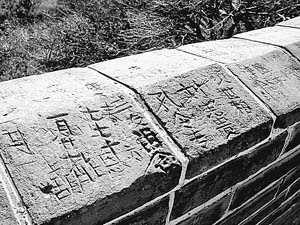|
Great Wall to get facelift after modern ravages
(AFP)
Updated: 2005-12-21 07:10
The popular Badaling section of China's Great Wall, which has suffered more
at the hands of modern visitors than the barbarian invaders it was meant to keep
out, may soon get a face lift.
About four million Chinese and foreign tourists visit the Badaling section
near Beijing each year and many have carved their names and other graffiti such
as "I have toured the Great Wall," on its bricks, the Xinhua news agency said.

"The wall looks like a newspaper in the sun. Nearly every piece of brick on
the Badaling section of the Great Wall has carvings," said Zheng Yan of the
China Great Wall Society on Tuesday.
The society and administrators of the section in November began soliciting
suggestions from the public on how to clean the wall without damaging it.
They received hundreds of suggestions, with some coming from abroad, but
still have not come up with a proper solution.
Most marks, mainly names and expressions of love, were written or carved
between the 1960s and 1990s, according to the society.
There were fewer recent marks due to better management and protection.
Volunteers are also helping to protect the Great Wall, including Sun Jing, a
72-year-old farmer who lives in a village near the wall. She volunteers to
collect rubbish and warn tourists against carving on the wall.
"Protecting the Great Wall is something the same as safeguarding my home," he
said.
The World Monument Fund has included the Great Wall in its 2004 list of the
"World's 100 Most Endangered Sites."
China's most famous cultural relic has also come under other harm.
Sections of the wall have been knocked down to make way for freeways while
other parts have undergone a tacky refurbishment to lure tourists.
Farmers have also seen the wall as a ready source of construction materials
and taken apart portions to build homes, schools and reservoirs.
Tourists were also climbing sections that have not been approved for
commercial activities or visitors.
Less than 2,500 kilometers (1,500 miles) remain of the original
6,300-kilometer structure that was first built in the Qin Dynasty (221-206
BC).
It was rebuilt in the Ming Dynasty (1368-1644) to keep out northern tribes
threatening the heartland.
|